A Comparative Analysis of Traditional and Activity-Based Costing
VerifiedAdded on 2023/06/11
|11
|2229
|346
Report
AI Summary
This report provides a comprehensive analysis of traditional costing methods versus activity-based costing (ABC). It examines the problems associated with traditional costing in modern manufacturing environments, where overhead allocation based on volume-driven cost drivers can lead to inaccuracies. The report highlights the benefits of adopting ABC, including more accurate product costing, better identification of cost drivers, and improved waste reduction. However, it also acknowledges the limitations of ABC, such as its complexity and the potential for over-concentration on process control. The analysis includes a practical application comparing the costs of basic and advanced telephone systems using both departmental rates and ABC. Ultimately, the report recommends that contemporary manufacturing entities adopt ABC systems for more accurate overhead allocation and product pricing. Desklib provides access to this and other solved assignments to aid students in their studies.

Running head: INTRODUCTORY MANAGEMENT ACCOUNTING
Introductory management accounting
Name of the student
Name of the university
Student ID
Author note
Introductory management accounting
Name of the student
Name of the university
Student ID
Author note
Paraphrase This Document
Need a fresh take? Get an instant paraphrase of this document with our AI Paraphraser
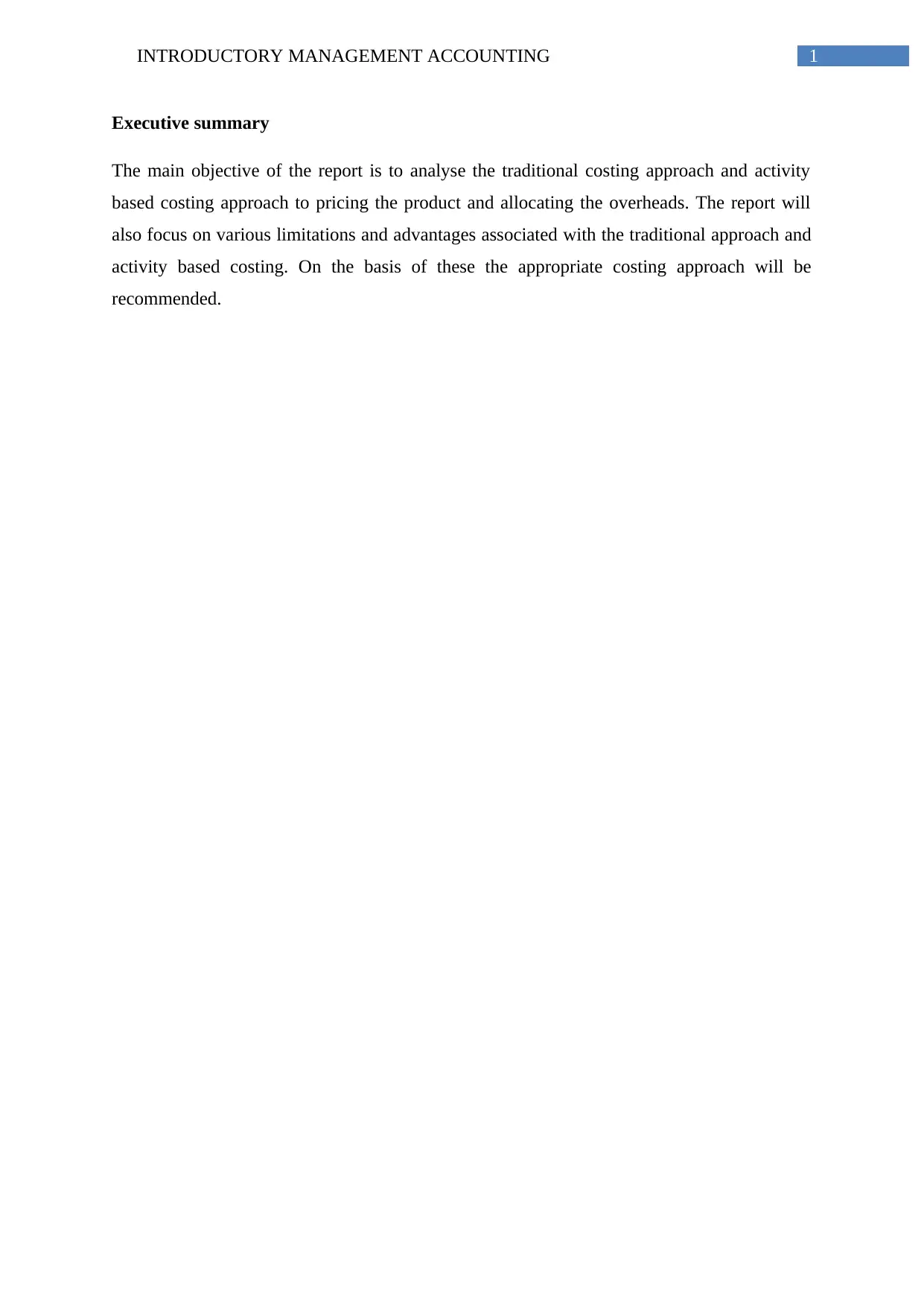
1INTRODUCTORY MANAGEMENT ACCOUNTING
Executive summary
The main objective of the report is to analyse the traditional costing approach and activity
based costing approach to pricing the product and allocating the overheads. The report will
also focus on various limitations and advantages associated with the traditional approach and
activity based costing. On the basis of these the appropriate costing approach will be
recommended.
Executive summary
The main objective of the report is to analyse the traditional costing approach and activity
based costing approach to pricing the product and allocating the overheads. The report will
also focus on various limitations and advantages associated with the traditional approach and
activity based costing. On the basis of these the appropriate costing approach will be
recommended.
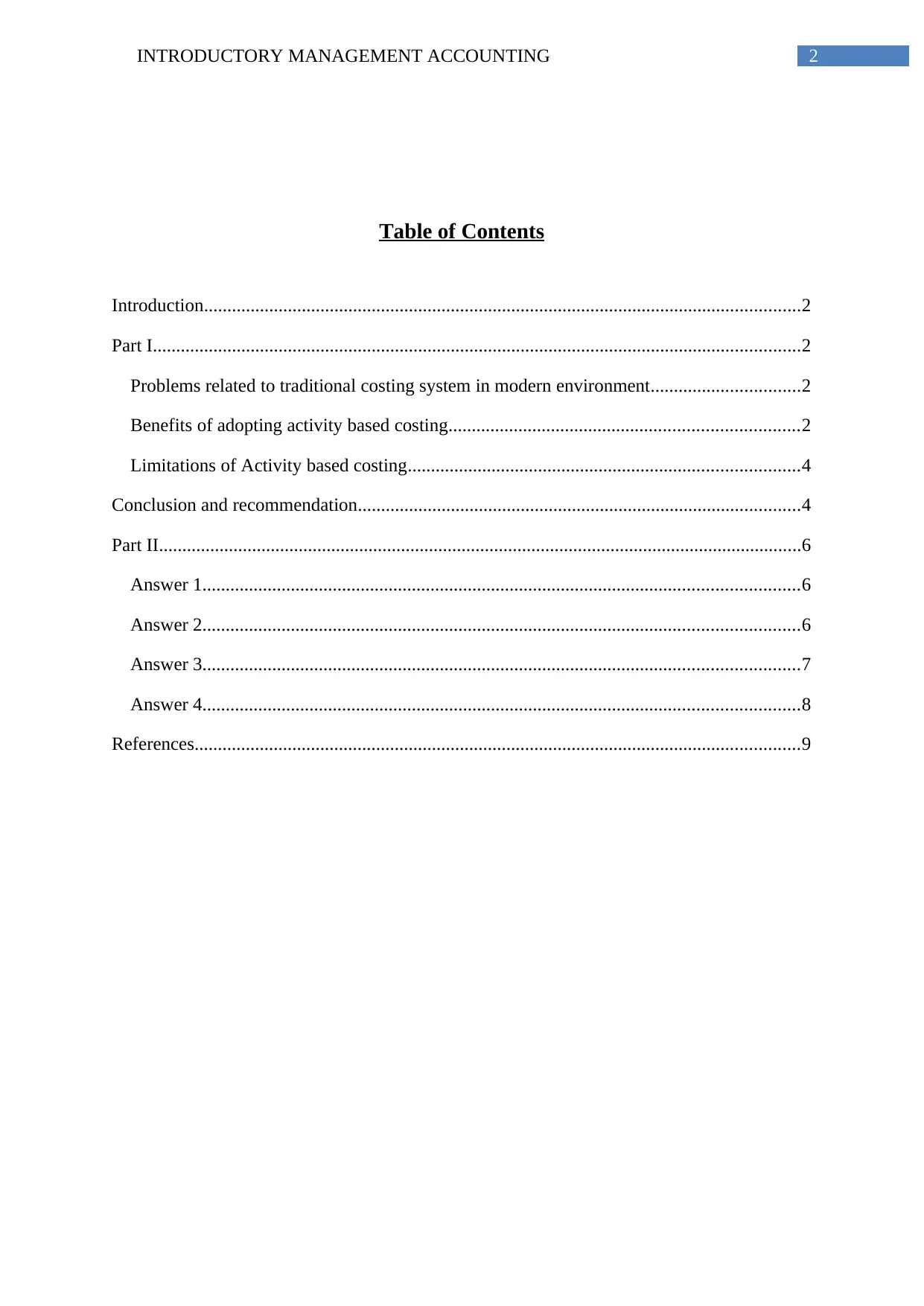
2INTRODUCTORY MANAGEMENT ACCOUNTING
Table of Contents
Introduction................................................................................................................................2
Part I...........................................................................................................................................2
Problems related to traditional costing system in modern environment................................2
Benefits of adopting activity based costing...........................................................................2
Limitations of Activity based costing....................................................................................4
Conclusion and recommendation...............................................................................................4
Part II..........................................................................................................................................6
Answer 1................................................................................................................................6
Answer 2................................................................................................................................6
Answer 3................................................................................................................................7
Answer 4................................................................................................................................8
References..................................................................................................................................9
Table of Contents
Introduction................................................................................................................................2
Part I...........................................................................................................................................2
Problems related to traditional costing system in modern environment................................2
Benefits of adopting activity based costing...........................................................................2
Limitations of Activity based costing....................................................................................4
Conclusion and recommendation...............................................................................................4
Part II..........................................................................................................................................6
Answer 1................................................................................................................................6
Answer 2................................................................................................................................6
Answer 3................................................................................................................................7
Answer 4................................................................................................................................8
References..................................................................................................................................9
⊘ This is a preview!⊘
Do you want full access?
Subscribe today to unlock all pages.

Trusted by 1+ million students worldwide
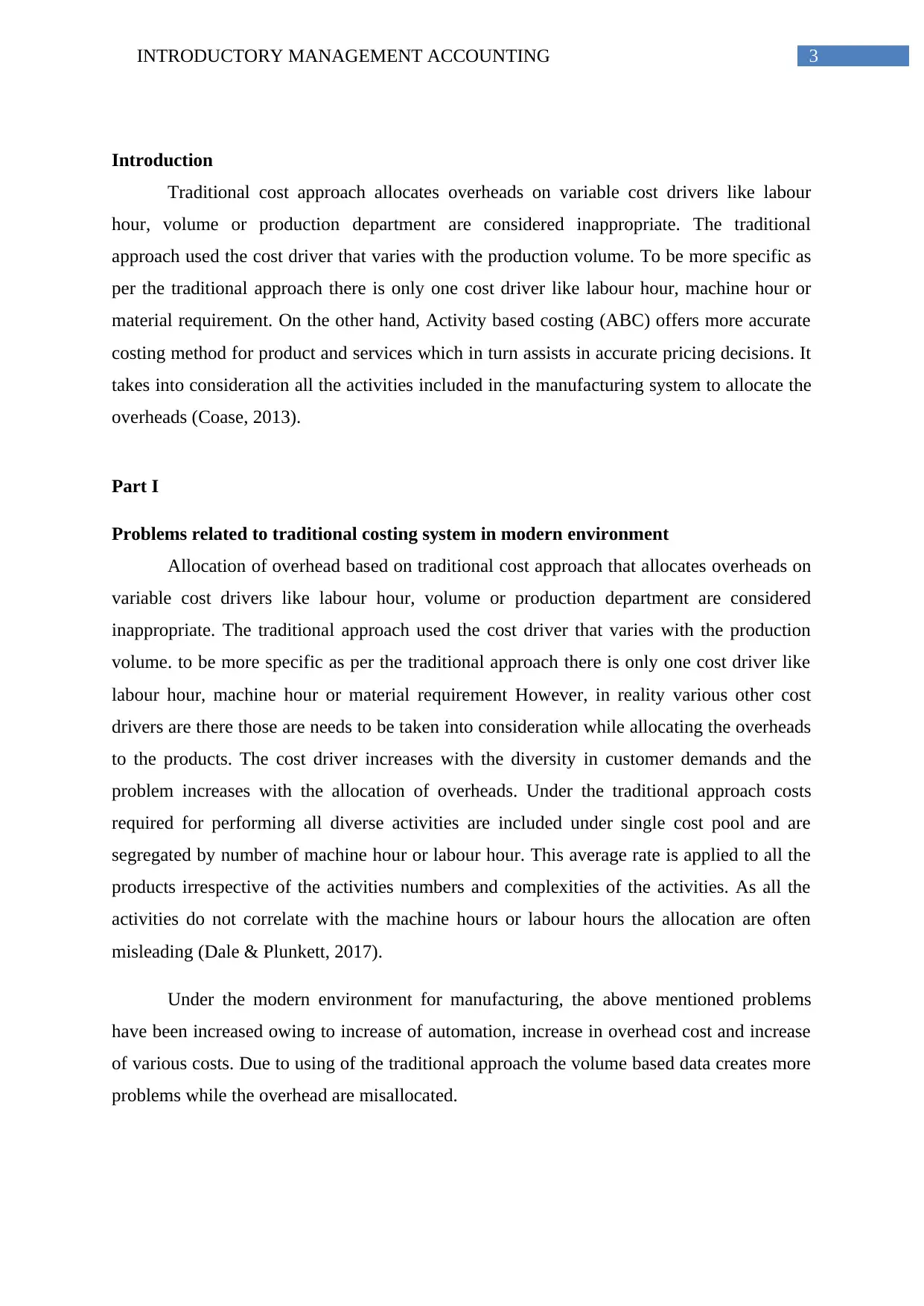
3INTRODUCTORY MANAGEMENT ACCOUNTING
Introduction
Traditional cost approach allocates overheads on variable cost drivers like labour
hour, volume or production department are considered inappropriate. The traditional
approach used the cost driver that varies with the production volume. To be more specific as
per the traditional approach there is only one cost driver like labour hour, machine hour or
material requirement. On the other hand, Activity based costing (ABC) offers more accurate
costing method for product and services which in turn assists in accurate pricing decisions. It
takes into consideration all the activities included in the manufacturing system to allocate the
overheads (Coase, 2013).
Part I
Problems related to traditional costing system in modern environment
Allocation of overhead based on traditional cost approach that allocates overheads on
variable cost drivers like labour hour, volume or production department are considered
inappropriate. The traditional approach used the cost driver that varies with the production
volume. to be more specific as per the traditional approach there is only one cost driver like
labour hour, machine hour or material requirement However, in reality various other cost
drivers are there those are needs to be taken into consideration while allocating the overheads
to the products. The cost driver increases with the diversity in customer demands and the
problem increases with the allocation of overheads. Under the traditional approach costs
required for performing all diverse activities are included under single cost pool and are
segregated by number of machine hour or labour hour. This average rate is applied to all the
products irrespective of the activities numbers and complexities of the activities. As all the
activities do not correlate with the machine hours or labour hours the allocation are often
misleading (Dale & Plunkett, 2017).
Under the modern environment for manufacturing, the above mentioned problems
have been increased owing to increase of automation, increase in overhead cost and increase
of various costs. Due to using of the traditional approach the volume based data creates more
problems while the overhead are misallocated.
Introduction
Traditional cost approach allocates overheads on variable cost drivers like labour
hour, volume or production department are considered inappropriate. The traditional
approach used the cost driver that varies with the production volume. To be more specific as
per the traditional approach there is only one cost driver like labour hour, machine hour or
material requirement. On the other hand, Activity based costing (ABC) offers more accurate
costing method for product and services which in turn assists in accurate pricing decisions. It
takes into consideration all the activities included in the manufacturing system to allocate the
overheads (Coase, 2013).
Part I
Problems related to traditional costing system in modern environment
Allocation of overhead based on traditional cost approach that allocates overheads on
variable cost drivers like labour hour, volume or production department are considered
inappropriate. The traditional approach used the cost driver that varies with the production
volume. to be more specific as per the traditional approach there is only one cost driver like
labour hour, machine hour or material requirement However, in reality various other cost
drivers are there those are needs to be taken into consideration while allocating the overheads
to the products. The cost driver increases with the diversity in customer demands and the
problem increases with the allocation of overheads. Under the traditional approach costs
required for performing all diverse activities are included under single cost pool and are
segregated by number of machine hour or labour hour. This average rate is applied to all the
products irrespective of the activities numbers and complexities of the activities. As all the
activities do not correlate with the machine hours or labour hours the allocation are often
misleading (Dale & Plunkett, 2017).
Under the modern environment for manufacturing, the above mentioned problems
have been increased owing to increase of automation, increase in overhead cost and increase
of various costs. Due to using of the traditional approach the volume based data creates more
problems while the overhead are misallocated.
Paraphrase This Document
Need a fresh take? Get an instant paraphrase of this document with our AI Paraphraser
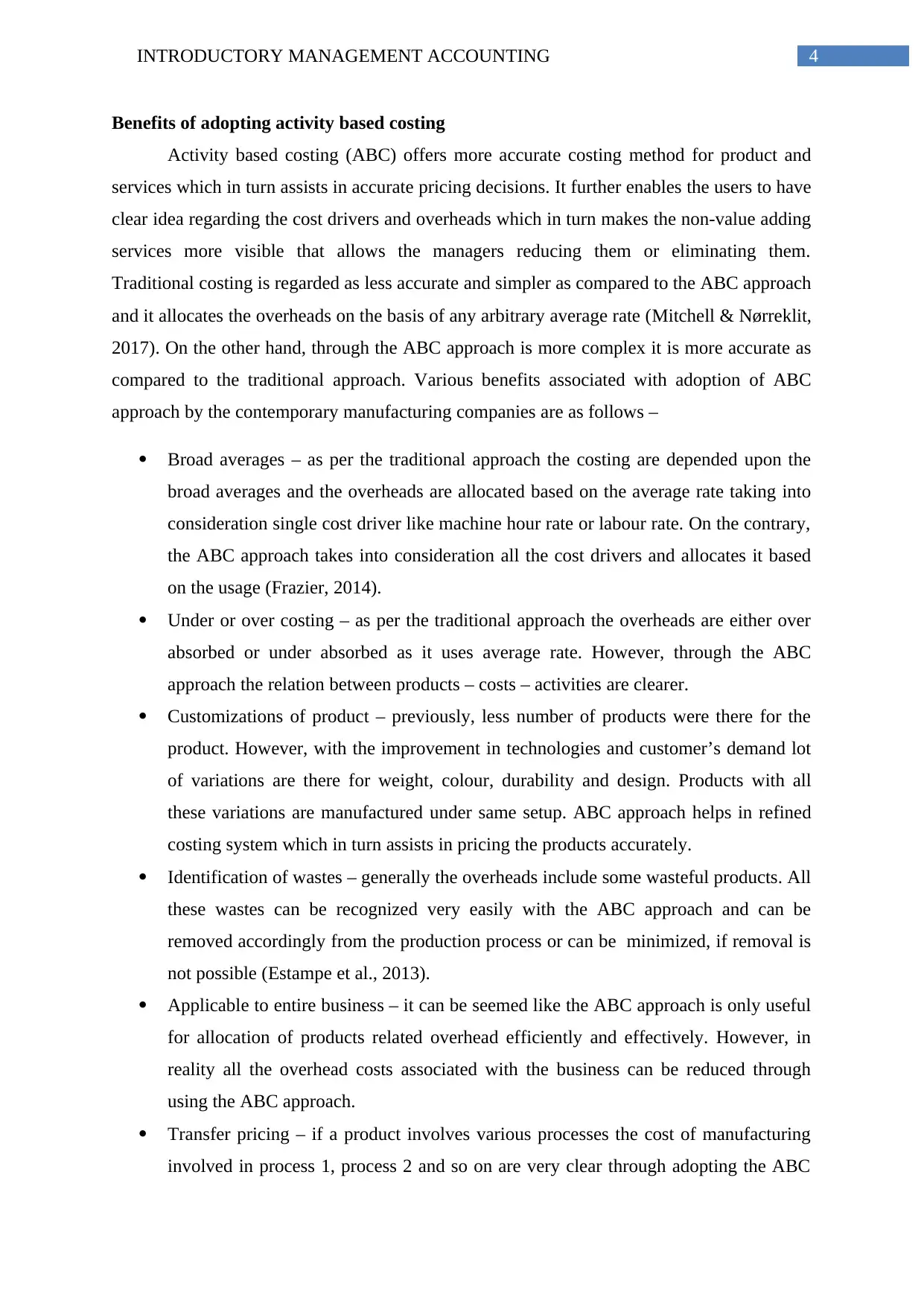
4INTRODUCTORY MANAGEMENT ACCOUNTING
Benefits of adopting activity based costing
Activity based costing (ABC) offers more accurate costing method for product and
services which in turn assists in accurate pricing decisions. It further enables the users to have
clear idea regarding the cost drivers and overheads which in turn makes the non-value adding
services more visible that allows the managers reducing them or eliminating them.
Traditional costing is regarded as less accurate and simpler as compared to the ABC approach
and it allocates the overheads on the basis of any arbitrary average rate (Mitchell & Nørreklit,
2017). On the other hand, through the ABC approach is more complex it is more accurate as
compared to the traditional approach. Various benefits associated with adoption of ABC
approach by the contemporary manufacturing companies are as follows –
Broad averages – as per the traditional approach the costing are depended upon the
broad averages and the overheads are allocated based on the average rate taking into
consideration single cost driver like machine hour rate or labour rate. On the contrary,
the ABC approach takes into consideration all the cost drivers and allocates it based
on the usage (Frazier, 2014).
Under or over costing – as per the traditional approach the overheads are either over
absorbed or under absorbed as it uses average rate. However, through the ABC
approach the relation between products – costs – activities are clearer.
Customizations of product – previously, less number of products were there for the
product. However, with the improvement in technologies and customer’s demand lot
of variations are there for weight, colour, durability and design. Products with all
these variations are manufactured under same setup. ABC approach helps in refined
costing system which in turn assists in pricing the products accurately.
Identification of wastes – generally the overheads include some wasteful products. All
these wastes can be recognized very easily with the ABC approach and can be
removed accordingly from the production process or can be minimized, if removal is
not possible (Estampe et al., 2013).
Applicable to entire business – it can be seemed like the ABC approach is only useful
for allocation of products related overhead efficiently and effectively. However, in
reality all the overhead costs associated with the business can be reduced through
using the ABC approach.
Transfer pricing – if a product involves various processes the cost of manufacturing
involved in process 1, process 2 and so on are very clear through adopting the ABC
Benefits of adopting activity based costing
Activity based costing (ABC) offers more accurate costing method for product and
services which in turn assists in accurate pricing decisions. It further enables the users to have
clear idea regarding the cost drivers and overheads which in turn makes the non-value adding
services more visible that allows the managers reducing them or eliminating them.
Traditional costing is regarded as less accurate and simpler as compared to the ABC approach
and it allocates the overheads on the basis of any arbitrary average rate (Mitchell & Nørreklit,
2017). On the other hand, through the ABC approach is more complex it is more accurate as
compared to the traditional approach. Various benefits associated with adoption of ABC
approach by the contemporary manufacturing companies are as follows –
Broad averages – as per the traditional approach the costing are depended upon the
broad averages and the overheads are allocated based on the average rate taking into
consideration single cost driver like machine hour rate or labour rate. On the contrary,
the ABC approach takes into consideration all the cost drivers and allocates it based
on the usage (Frazier, 2014).
Under or over costing – as per the traditional approach the overheads are either over
absorbed or under absorbed as it uses average rate. However, through the ABC
approach the relation between products – costs – activities are clearer.
Customizations of product – previously, less number of products were there for the
product. However, with the improvement in technologies and customer’s demand lot
of variations are there for weight, colour, durability and design. Products with all
these variations are manufactured under same setup. ABC approach helps in refined
costing system which in turn assists in pricing the products accurately.
Identification of wastes – generally the overheads include some wasteful products. All
these wastes can be recognized very easily with the ABC approach and can be
removed accordingly from the production process or can be minimized, if removal is
not possible (Estampe et al., 2013).
Applicable to entire business – it can be seemed like the ABC approach is only useful
for allocation of products related overhead efficiently and effectively. However, in
reality all the overhead costs associated with the business can be reduced through
using the ABC approach.
Transfer pricing – if a product involves various processes the cost of manufacturing
involved in process 1, process 2 and so on are very clear through adopting the ABC
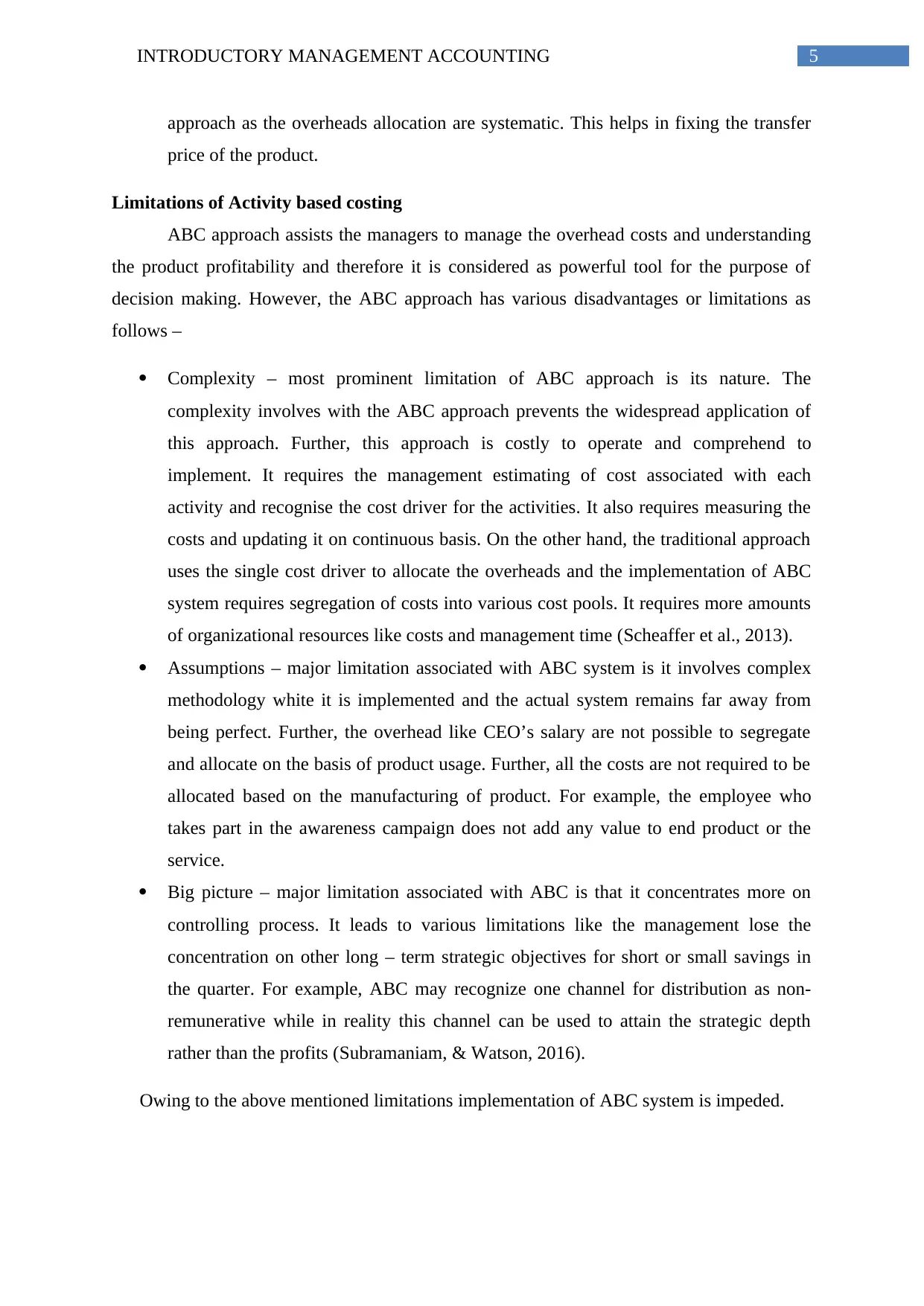
5INTRODUCTORY MANAGEMENT ACCOUNTING
approach as the overheads allocation are systematic. This helps in fixing the transfer
price of the product.
Limitations of Activity based costing
ABC approach assists the managers to manage the overhead costs and understanding
the product profitability and therefore it is considered as powerful tool for the purpose of
decision making. However, the ABC approach has various disadvantages or limitations as
follows –
Complexity – most prominent limitation of ABC approach is its nature. The
complexity involves with the ABC approach prevents the widespread application of
this approach. Further, this approach is costly to operate and comprehend to
implement. It requires the management estimating of cost associated with each
activity and recognise the cost driver for the activities. It also requires measuring the
costs and updating it on continuous basis. On the other hand, the traditional approach
uses the single cost driver to allocate the overheads and the implementation of ABC
system requires segregation of costs into various cost pools. It requires more amounts
of organizational resources like costs and management time (Scheaffer et al., 2013).
Assumptions – major limitation associated with ABC system is it involves complex
methodology white it is implemented and the actual system remains far away from
being perfect. Further, the overhead like CEO’s salary are not possible to segregate
and allocate on the basis of product usage. Further, all the costs are not required to be
allocated based on the manufacturing of product. For example, the employee who
takes part in the awareness campaign does not add any value to end product or the
service.
Big picture – major limitation associated with ABC is that it concentrates more on
controlling process. It leads to various limitations like the management lose the
concentration on other long – term strategic objectives for short or small savings in
the quarter. For example, ABC may recognize one channel for distribution as non-
remunerative while in reality this channel can be used to attain the strategic depth
rather than the profits (Subramaniam, & Watson, 2016).
Owing to the above mentioned limitations implementation of ABC system is impeded.
approach as the overheads allocation are systematic. This helps in fixing the transfer
price of the product.
Limitations of Activity based costing
ABC approach assists the managers to manage the overhead costs and understanding
the product profitability and therefore it is considered as powerful tool for the purpose of
decision making. However, the ABC approach has various disadvantages or limitations as
follows –
Complexity – most prominent limitation of ABC approach is its nature. The
complexity involves with the ABC approach prevents the widespread application of
this approach. Further, this approach is costly to operate and comprehend to
implement. It requires the management estimating of cost associated with each
activity and recognise the cost driver for the activities. It also requires measuring the
costs and updating it on continuous basis. On the other hand, the traditional approach
uses the single cost driver to allocate the overheads and the implementation of ABC
system requires segregation of costs into various cost pools. It requires more amounts
of organizational resources like costs and management time (Scheaffer et al., 2013).
Assumptions – major limitation associated with ABC system is it involves complex
methodology white it is implemented and the actual system remains far away from
being perfect. Further, the overhead like CEO’s salary are not possible to segregate
and allocate on the basis of product usage. Further, all the costs are not required to be
allocated based on the manufacturing of product. For example, the employee who
takes part in the awareness campaign does not add any value to end product or the
service.
Big picture – major limitation associated with ABC is that it concentrates more on
controlling process. It leads to various limitations like the management lose the
concentration on other long – term strategic objectives for short or small savings in
the quarter. For example, ABC may recognize one channel for distribution as non-
remunerative while in reality this channel can be used to attain the strategic depth
rather than the profits (Subramaniam, & Watson, 2016).
Owing to the above mentioned limitations implementation of ABC system is impeded.
⊘ This is a preview!⊘
Do you want full access?
Subscribe today to unlock all pages.

Trusted by 1+ million students worldwide

6INTRODUCTORY MANAGEMENT ACCOUNTING
Conclusion and recommendation
From the above analysis it is concluded that traditional method of costing is simple
and it considers the single cost driver to allocate the overheads. On the contrary, the ABC
system takes into consideration all the cost drivers while allocating the overheads. However,
the ABC system is costlier and more complex to implement as compared to the traditional
approach. Though the ABC system is costlier and complex it has various advantages that
allow the management to accurate overhead allocation and fixing the price of the product.
Therefore, the contemporary manufacturing entities are recommended to adopt ABC system.
Conclusion and recommendation
From the above analysis it is concluded that traditional method of costing is simple
and it considers the single cost driver to allocate the overheads. On the contrary, the ABC
system takes into consideration all the cost drivers while allocating the overheads. However,
the ABC system is costlier and more complex to implement as compared to the traditional
approach. Though the ABC system is costlier and complex it has various advantages that
allow the management to accurate overhead allocation and fixing the price of the product.
Therefore, the contemporary manufacturing entities are recommended to adopt ABC system.
Paraphrase This Document
Need a fresh take? Get an instant paraphrase of this document with our AI Paraphraser

7INTRODUCTORY MANAGEMENT ACCOUNTING
Part II
Answer 1
Cost per Basic Telephone System and Advanced telephone system using the
departmental rates –
Answer 2
Cost per Basis Telephone System and Advanced telephone system using the Activity
Based Costing –
Part II
Answer 1
Cost per Basic Telephone System and Advanced telephone system using the
departmental rates –
Answer 2
Cost per Basis Telephone System and Advanced telephone system using the Activity
Based Costing –
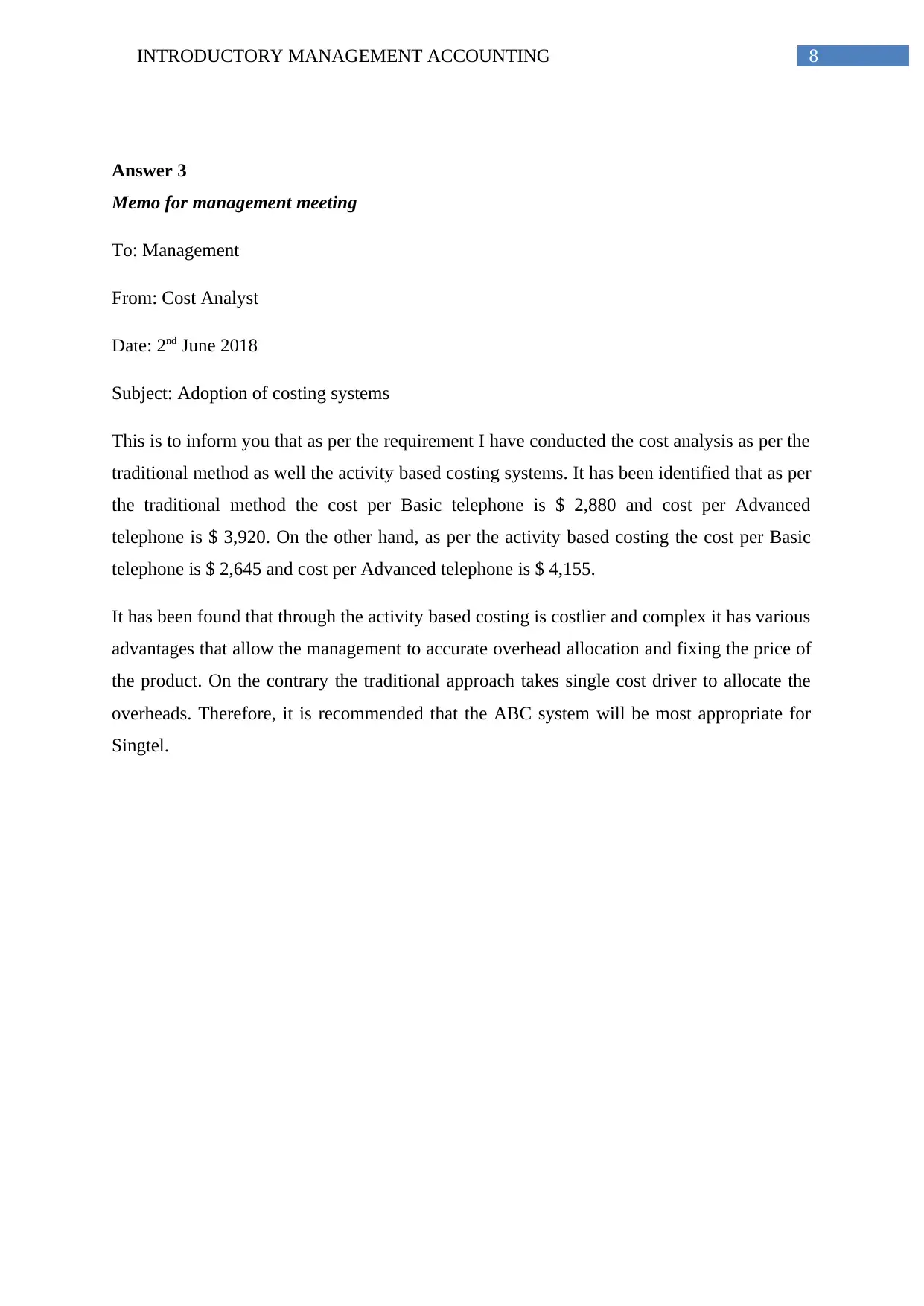
8INTRODUCTORY MANAGEMENT ACCOUNTING
Answer 3
Memo for management meeting
To: Management
From: Cost Analyst
Date: 2nd June 2018
Subject: Adoption of costing systems
This is to inform you that as per the requirement I have conducted the cost analysis as per the
traditional method as well the activity based costing systems. It has been identified that as per
the traditional method the cost per Basic telephone is $ 2,880 and cost per Advanced
telephone is $ 3,920. On the other hand, as per the activity based costing the cost per Basic
telephone is $ 2,645 and cost per Advanced telephone is $ 4,155.
It has been found that through the activity based costing is costlier and complex it has various
advantages that allow the management to accurate overhead allocation and fixing the price of
the product. On the contrary the traditional approach takes single cost driver to allocate the
overheads. Therefore, it is recommended that the ABC system will be most appropriate for
Singtel.
Answer 3
Memo for management meeting
To: Management
From: Cost Analyst
Date: 2nd June 2018
Subject: Adoption of costing systems
This is to inform you that as per the requirement I have conducted the cost analysis as per the
traditional method as well the activity based costing systems. It has been identified that as per
the traditional method the cost per Basic telephone is $ 2,880 and cost per Advanced
telephone is $ 3,920. On the other hand, as per the activity based costing the cost per Basic
telephone is $ 2,645 and cost per Advanced telephone is $ 4,155.
It has been found that through the activity based costing is costlier and complex it has various
advantages that allow the management to accurate overhead allocation and fixing the price of
the product. On the contrary the traditional approach takes single cost driver to allocate the
overheads. Therefore, it is recommended that the ABC system will be most appropriate for
Singtel.
⊘ This is a preview!⊘
Do you want full access?
Subscribe today to unlock all pages.

Trusted by 1+ million students worldwide

9INTRODUCTORY MANAGEMENT ACCOUNTING
Answer 4
Implication of adopting traditional costing system
Under the traditional costing system overheads are allocated based on variable cost
drivers like labour hour, volume or production department. The traditional approach uses the
cost driver that varies with the production volume. to be more specific as per the traditional
approach there is only one cost driver like labour hour, machine hour or material requirement
However, in reality various other cost drivers are there those are needs to be taken into
consideration while allocating the overheads to the products (Drury, 2013). However, this is
used by the companies as it is simple, involves lower cost for implementation and less
complex as compared to ABC. The pricing decisions taken based on the traditional approach
are considered inappropriate as various cost drivers are not taken into consideration while
allocating the overheads.
Implication of adopting ABC system
ABC system enables the users to have clear idea regarding the cost drivers and
overheads as all the overheads are taken into consideration. Traditional costing is regarded as
less accurate and simpler as compared to the ABC approach as it allocates the overheads on
the basis of arbitrary average rate. On the other hand, though the ABC approach is more
complex it is more accurate as compared to the traditional approach (Hilton & Platt, 2013).
The pricing decisions taken based on the ABC approach are considered most appropriate as
all the cost drivers are taken into consideration while allocating the overheads.
Answer 4
Implication of adopting traditional costing system
Under the traditional costing system overheads are allocated based on variable cost
drivers like labour hour, volume or production department. The traditional approach uses the
cost driver that varies with the production volume. to be more specific as per the traditional
approach there is only one cost driver like labour hour, machine hour or material requirement
However, in reality various other cost drivers are there those are needs to be taken into
consideration while allocating the overheads to the products (Drury, 2013). However, this is
used by the companies as it is simple, involves lower cost for implementation and less
complex as compared to ABC. The pricing decisions taken based on the traditional approach
are considered inappropriate as various cost drivers are not taken into consideration while
allocating the overheads.
Implication of adopting ABC system
ABC system enables the users to have clear idea regarding the cost drivers and
overheads as all the overheads are taken into consideration. Traditional costing is regarded as
less accurate and simpler as compared to the ABC approach as it allocates the overheads on
the basis of arbitrary average rate. On the other hand, though the ABC approach is more
complex it is more accurate as compared to the traditional approach (Hilton & Platt, 2013).
The pricing decisions taken based on the ABC approach are considered most appropriate as
all the cost drivers are taken into consideration while allocating the overheads.
Paraphrase This Document
Need a fresh take? Get an instant paraphrase of this document with our AI Paraphraser
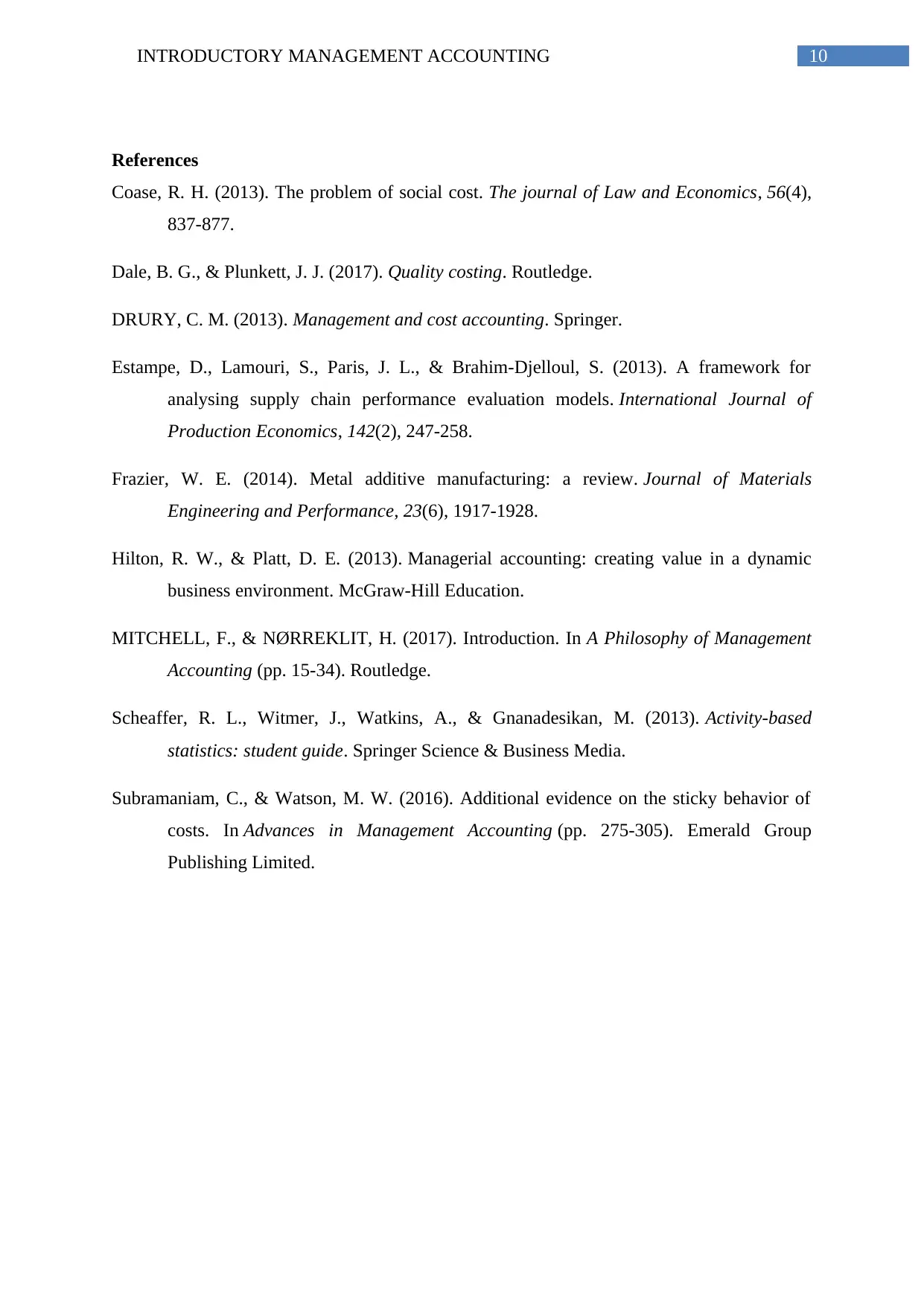
10INTRODUCTORY MANAGEMENT ACCOUNTING
References
Coase, R. H. (2013). The problem of social cost. The journal of Law and Economics, 56(4),
837-877.
Dale, B. G., & Plunkett, J. J. (2017). Quality costing. Routledge.
DRURY, C. M. (2013). Management and cost accounting. Springer.
Estampe, D., Lamouri, S., Paris, J. L., & Brahim-Djelloul, S. (2013). A framework for
analysing supply chain performance evaluation models. International Journal of
Production Economics, 142(2), 247-258.
Frazier, W. E. (2014). Metal additive manufacturing: a review. Journal of Materials
Engineering and Performance, 23(6), 1917-1928.
Hilton, R. W., & Platt, D. E. (2013). Managerial accounting: creating value in a dynamic
business environment. McGraw-Hill Education.
MITCHELL, F., & NØRREKLIT, H. (2017). Introduction. In A Philosophy of Management
Accounting (pp. 15-34). Routledge.
Scheaffer, R. L., Witmer, J., Watkins, A., & Gnanadesikan, M. (2013). Activity-based
statistics: student guide. Springer Science & Business Media.
Subramaniam, C., & Watson, M. W. (2016). Additional evidence on the sticky behavior of
costs. In Advances in Management Accounting (pp. 275-305). Emerald Group
Publishing Limited.
References
Coase, R. H. (2013). The problem of social cost. The journal of Law and Economics, 56(4),
837-877.
Dale, B. G., & Plunkett, J. J. (2017). Quality costing. Routledge.
DRURY, C. M. (2013). Management and cost accounting. Springer.
Estampe, D., Lamouri, S., Paris, J. L., & Brahim-Djelloul, S. (2013). A framework for
analysing supply chain performance evaluation models. International Journal of
Production Economics, 142(2), 247-258.
Frazier, W. E. (2014). Metal additive manufacturing: a review. Journal of Materials
Engineering and Performance, 23(6), 1917-1928.
Hilton, R. W., & Platt, D. E. (2013). Managerial accounting: creating value in a dynamic
business environment. McGraw-Hill Education.
MITCHELL, F., & NØRREKLIT, H. (2017). Introduction. In A Philosophy of Management
Accounting (pp. 15-34). Routledge.
Scheaffer, R. L., Witmer, J., Watkins, A., & Gnanadesikan, M. (2013). Activity-based
statistics: student guide. Springer Science & Business Media.
Subramaniam, C., & Watson, M. W. (2016). Additional evidence on the sticky behavior of
costs. In Advances in Management Accounting (pp. 275-305). Emerald Group
Publishing Limited.
1 out of 11
Related Documents
Your All-in-One AI-Powered Toolkit for Academic Success.
+13062052269
info@desklib.com
Available 24*7 on WhatsApp / Email
![[object Object]](/_next/static/media/star-bottom.7253800d.svg)
Unlock your academic potential
Copyright © 2020–2025 A2Z Services. All Rights Reserved. Developed and managed by ZUCOL.





